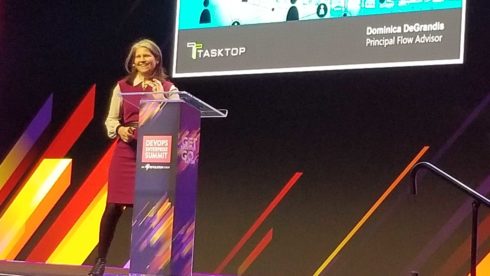
New ways of doing work, such as shifting from a project mentality to a value-centric product mentality, spurs the need for new roles in software.
That was the focus of a session here at the DevOps Enterprise Summit this morning presented by Dominica DeGrandis, the new principal flow advisor at Tasktop, who outlined the difference between project teams and product teams.
For instance, the job of a product team is to create business value, which is different from a project team that is optimizing is efforts around project scope, budget and scheduling. Further, she said, product teams have cross-functional groups, while project teams are usually split up. A product team has its focus on business outcomes, while a project team looks at “activities, which involve counting,” she said.
RELATED CONTENT:
The new age of Agile: Evolving from teams to the entire business
Flowing value into your transformation
Gently down the value stream
Project teams form and disband, while product teams have longevity, stability and the knowledge lives with the same team. A project-centric view requires bringing people together to work, while the product view brings work to the people, she noted.
So what does this mean for skills? DeGrandis pointed out that the concept of a full-stack developer is elusive. Those people are hard for companies to find and hire, primarily, she half-joked, because they’re all working at Netflix.
The shift from project to product will require a change in the program management office, which DeGrandis said is starting to morph into a value management office, “to help optimize business outcomes,” she said.
Among the new roles in this office will be the value stream architect, the value stream product lead, and the product journey owner or champion, she said. The value stream architect is focused on optimizing the flow of business value, optimizing the pipeline itself, and ensuring that good feedback occurs, among other tasks.
The product journey champion is the IT business-level owner of the transition from project to product. This person works with executives and managers in IT and the business to adopt this mindset, which leads to optimized investments in technology.
The product value stream lead has intimate knowledge of the product and customers, while emphasizing team happiness and measuring the team’s success.
A skills matrix can be adopted to help the organization find the gaps in its knowledge, and locate where those with more advanced skills in particular areas — artifact mapping, identifying dependencies, design experiments, and more — can help train those just getting on board.






